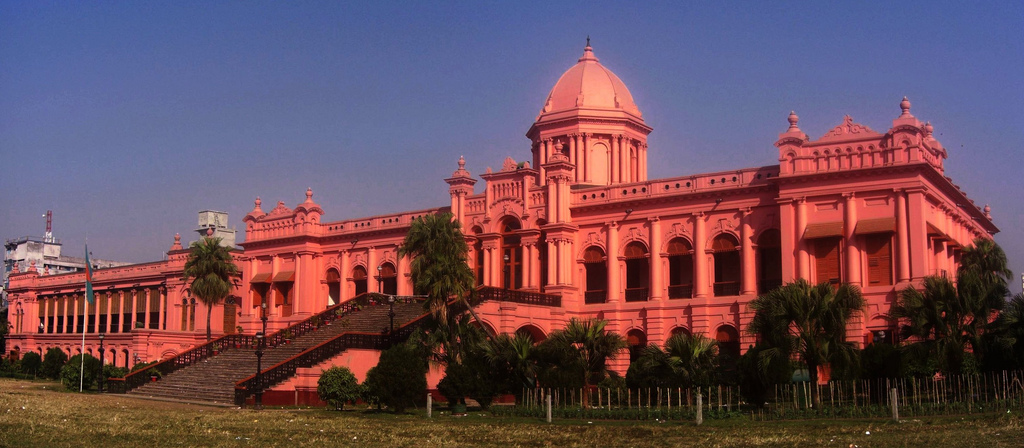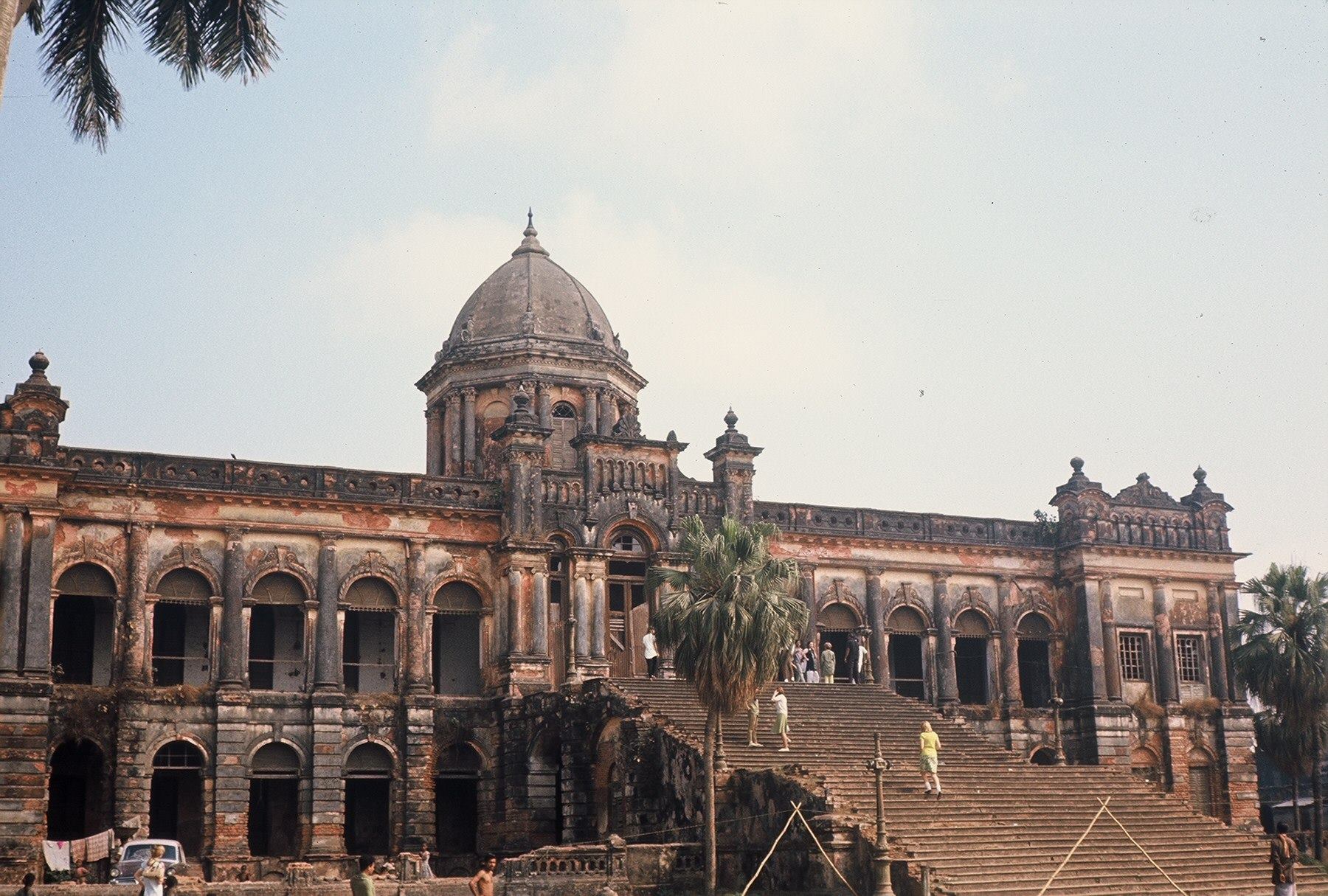Ahsan Manzil, also known as the Pink Palace, was the official residence and seat of the Dhaka Nawab family. Located in Kumartoli along the Buriganga River in Dhaka, Bangladesh, this architectural marvel was constructed between 1859 and 1869 in the Indo-Saracenic Revival style. It was converted into the Bangladesh National Museum on September 20, 1992, preserving its rich cultural and historical legacy.

Historical Background
During the Mughal era, Sheikh Enayet Ullah, a prominent landlord of Jamalpur Porgona (now part of a district), was known for his charm and opulence. He owned an expansive estate in Kumortuli (or Kumartuli), which he transformed into a magnificent garden house.
Sheikh Enayet Ullah built an exquisite palace at the heart of this estate, naming it Rongmohol (or Rangmahal). The palace was not just a home but a place of grand luxury and enjoyment. He hosted lavish gatherings, entertaining guests with beautifully dressed women from across the region and beyond, adorning them in sumptuous outfits and sparkling jewels.
However, the grandeur of Rongmohol and Sheikh Enayet Ullah’s lifestyle did not go unnoticed. The foujdar of Dhaka, the Mughal emperor’s local representative, became infatuated with one of these beautiful women. Consumed by jealousy and a desire to possess her, the foujdar devised a sinister plan.
One night, he invited Sheikh Enayet Ullah to a seemingly friendly party. But it was a trap. As Sheikh Enayet Ullah left the party and headed home, he was ambushed and killed in a conspiracy orchestrated by the foujdar. Devastated by the loss and driven by sorrow, the woman whom the foujdar coveted took her own life.
In the northeast corner of the palace grounds, Sheikh Enayet Ullah was initially buried in a grave. Unfortunately, by the early 20th century, this final resting place fell into neglect and ruin, and the grave was eventually destroyed, leaving behind only memories of the once-great palace and its tragic history.

After his death, his son sold the property to French traders, who established a trading house next to the Rong Mahal. The French were later defeated by the British in 1757 and had to leave their possessions behind.
The property then came into the hands of Khwaja Alimullah, who was a prominent merchant and leader of Dhaka’s Muslim community. He renovated Rong Mahal and turned it into his residence. He also built a mosque and some other important structures in this area. His son, Khwaja Abdul Ghani, inherited the property after his father’s death in 1854. He named it Ahsan Manzil after his son Khwaja Ahsanullah.
In 1888, Ahsan Manzil suffered severe damage from a tornado that destroyed most of its buildings except for Rangmahal. Khwaja Abdul Ghani decided to rebuild Ahsan Manzil with more strength and beauty than before. He hired an English architect named Martin & Co., who designed Ahsan Manzil with an Indo-Saracenic style that blended Islamic and European elements.
The reconstruction work was completed in 1872 under Khwaja Abdul Ghani’s supervision until he died in 1896 at age 87 years old. His son Khwaja Ahsanullah continued his father’s legacy by maintaining Ahsan Manzil as well as supporting various causes such as education, religion, charity, etc. He also added some features, such as electric lights, gas lamps, water pumps, etc . to modernize Ahsan Manzil.
Khwaja Ahsanullah was also known for hosting lavish parties, receptions, ceremonies, etc. at Ahsan Manzil for distinguished guests such as British officials, Indian princes, foreign dignitaries, etc. He also invited famous poets, musicians, artists, scholars, etc. to perform or present at Ahsan Manzil. He died in 1901 at age 53 years old.
Architectural Significance
Ahsan Manzil is a prominent example of Indo-Saracenic architecture. The palace stands on a raised platform of 1 meter and measures 125.4 meters by 28.75 meters. It features two stories, with the ground floor at 5 meters high and the first floor at 5.8 meters. The walls are approximately 0.78 meters thick. The palace has entrances on the northern and southern sides, leading to spacious verandahs and terraces.
The building is divided into two main sections:
- Rang Mahal (Eastern Side): Includes a large drawing room, card room, library, stateroom, and guest rooms. The high octagonal dome, which rises 27.13 meters above the ground, is a central feature, designed to resemble a lotus bud.
- Andarmahal (Western Side): Houses the ballroom, Hindustani room, dining hall, and additional residential rooms. The floors are decorated with colorful ceramic tiles, and the interiors feature wooden vaulted ceilings and intricate geometric designs.


Historical Highlights
Ahsan Manzil has hosted many notable figures:
- 1874: Lord Northbrook, the Governor General of India, visited to inaugurate a waterworks installed by Nawab Abdul Ghani.
- 1888: Lord Dufferin visited and was hosted at the palace.
- 1904: Lord Curzon stayed at Ahsan Manzil to garner support for the proposed Partition of Bengal.
The palace played a central role in the political life of East Bengal. It was the site of many important meetings and events related to the All-India Muslim League.
How To Get There & Opening Hours
There is a direct bus service from Gulistan to Dhaka. You can also go by private car or auto CNG rickshaw.
Days |
| Summer: April to September | Winter: October to March | During Ramadan |
Friday | 3:00 AM to 8:00 PM | 3:00 AM to 8:00 PM | Closed | |
Saturday | 10:30 AM to 5:30 PM | 10:30 AM to 5:30 PM | 9:30 AM to 3:30 PM | |
Sunday | 10:30 AM to 5:30 PM | 10:30 AM to 5:30 PM | 9:30 AM to 3:30 PM | |
Monday | 10:30 AM to 5:30 PM | 10:30 AM to 5:30 PM | 9:30 AM to 3:30 PM | |
Tuesday | 10:30 AM to 5:30 PM | 10:30 AM to 5:30 PM | 9:30 AM to 3:30 PM | |
Wednesday | 10:30 AM to 5:30 PM | 10:30 AM to 5:30 PM | 9:30 AM to 3:30 PM | |
Thursday | The museum remains closed on Thursdays and any other public holidays.
| |||
Pink Palace Museum Entrance Fees
Every visitor must collect a ticket to enter the Pink Palace Museum. The ticket price varies depending on the visitor’s nationality. Here is a chart of ticket fees according to different nationalities:
Step into history at Ahsan Manzil Museum, Dhaka’s grand Pink Palace, an Indo-Saracenic masterpiece
Ticket Category / Nationality | Ticket Price |
Children (3-12 Years) | 10.00 taka |
Bangladeshi | 20.00 Taka |
Visitors from SAARC member countries | 300.00 Taka |
And any other foreign nationalities | 500.00 Taka |
No entry fee is required for disabled persons and children under three years.
The South Asian Association for Regional Cooperation (SAARC) has eight member countries (Afghanistan, Bangladesh, Bhutan, India, the Maldives, Nepal, Pakistan, and Sri Lanka).
Tips for Visitors
- Stay Hydrated: Bring a hat, sunscreen, and water to stay hydrated during your visit.
- Respect the Heritage: Avoid touching artifacts and exhibits to preserve the cultural heritage of the palace.
- Explore Comfortable Shoes: Wear comfortable footwear as there will be a lot of walking.
- Thoroughly: Take your time to fully appreciate the unique architecture and historical significance of the palace.
Enjoy your visit to Ahsan Manzil, where history and grandeur come alive!

